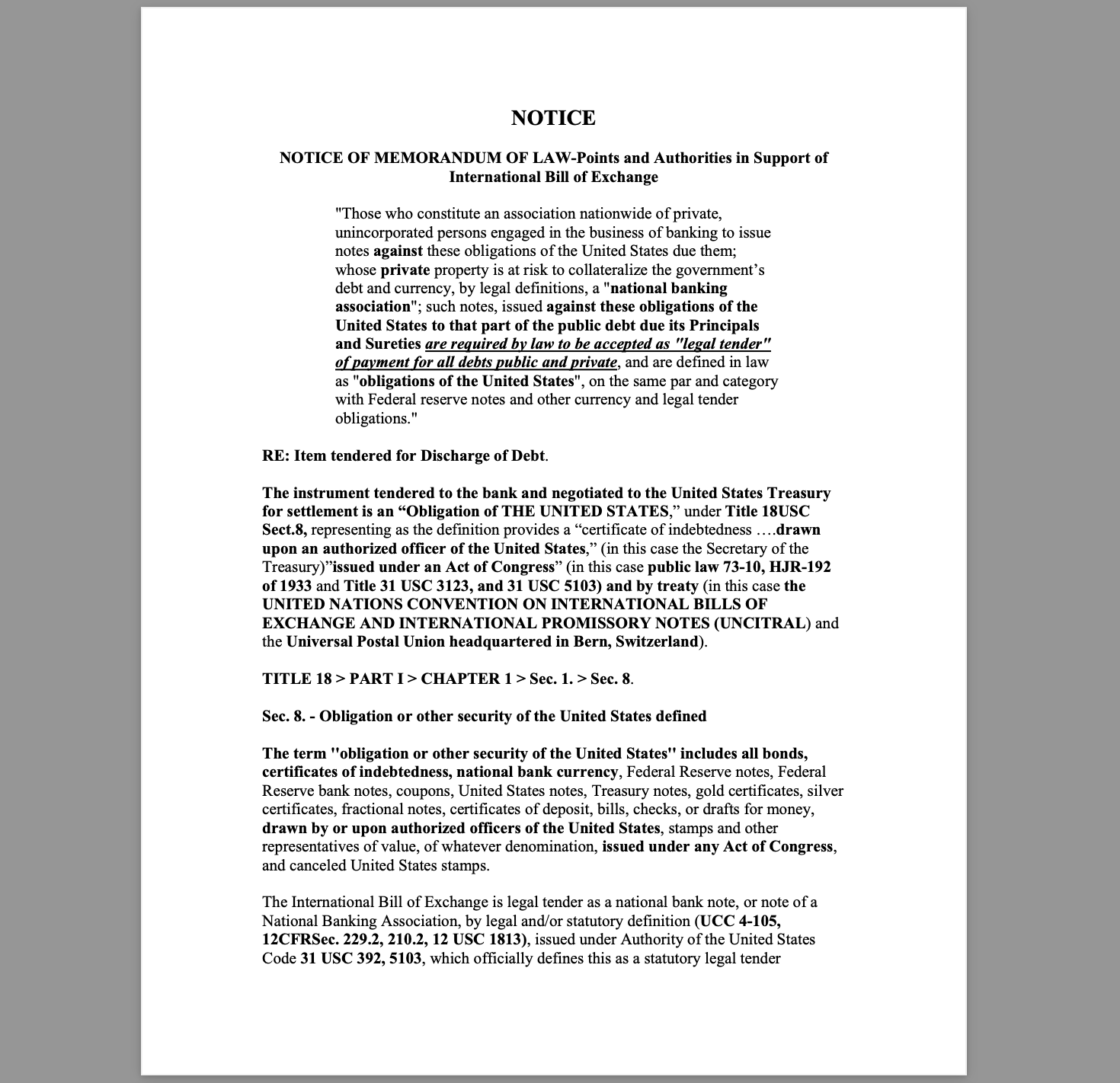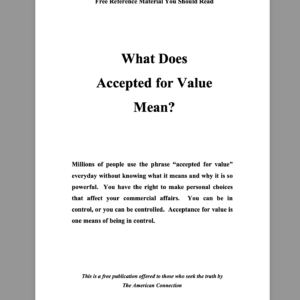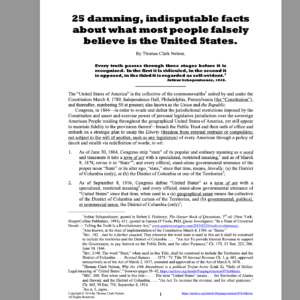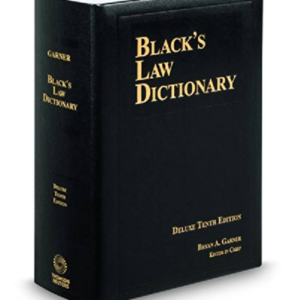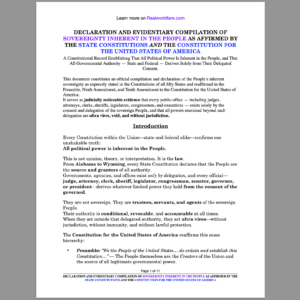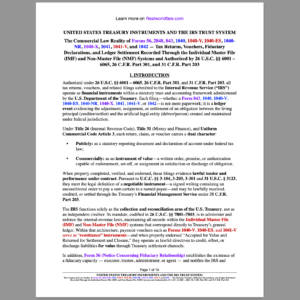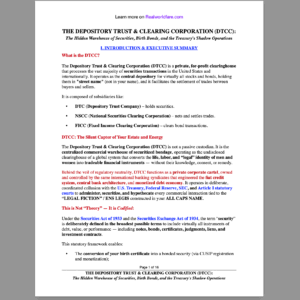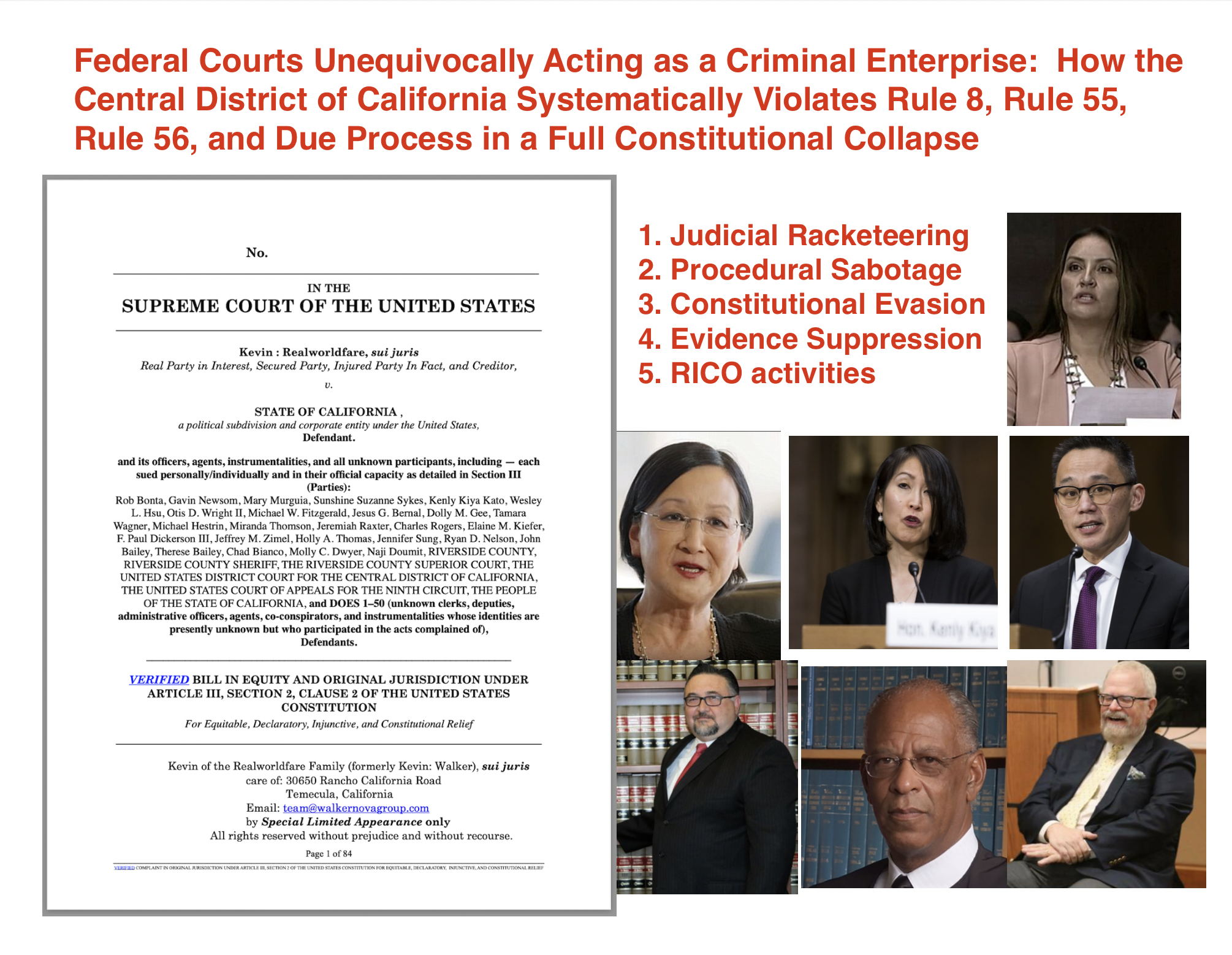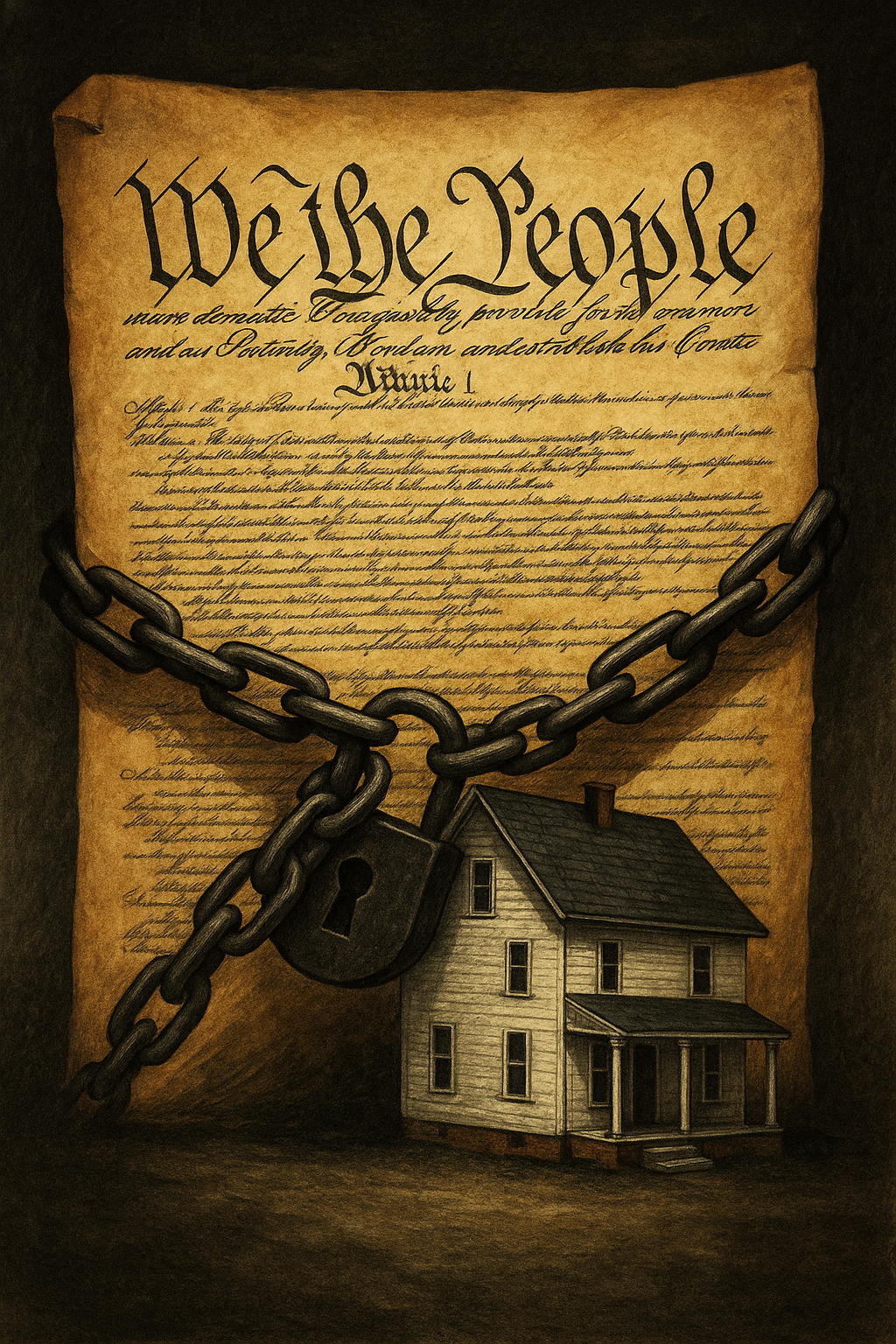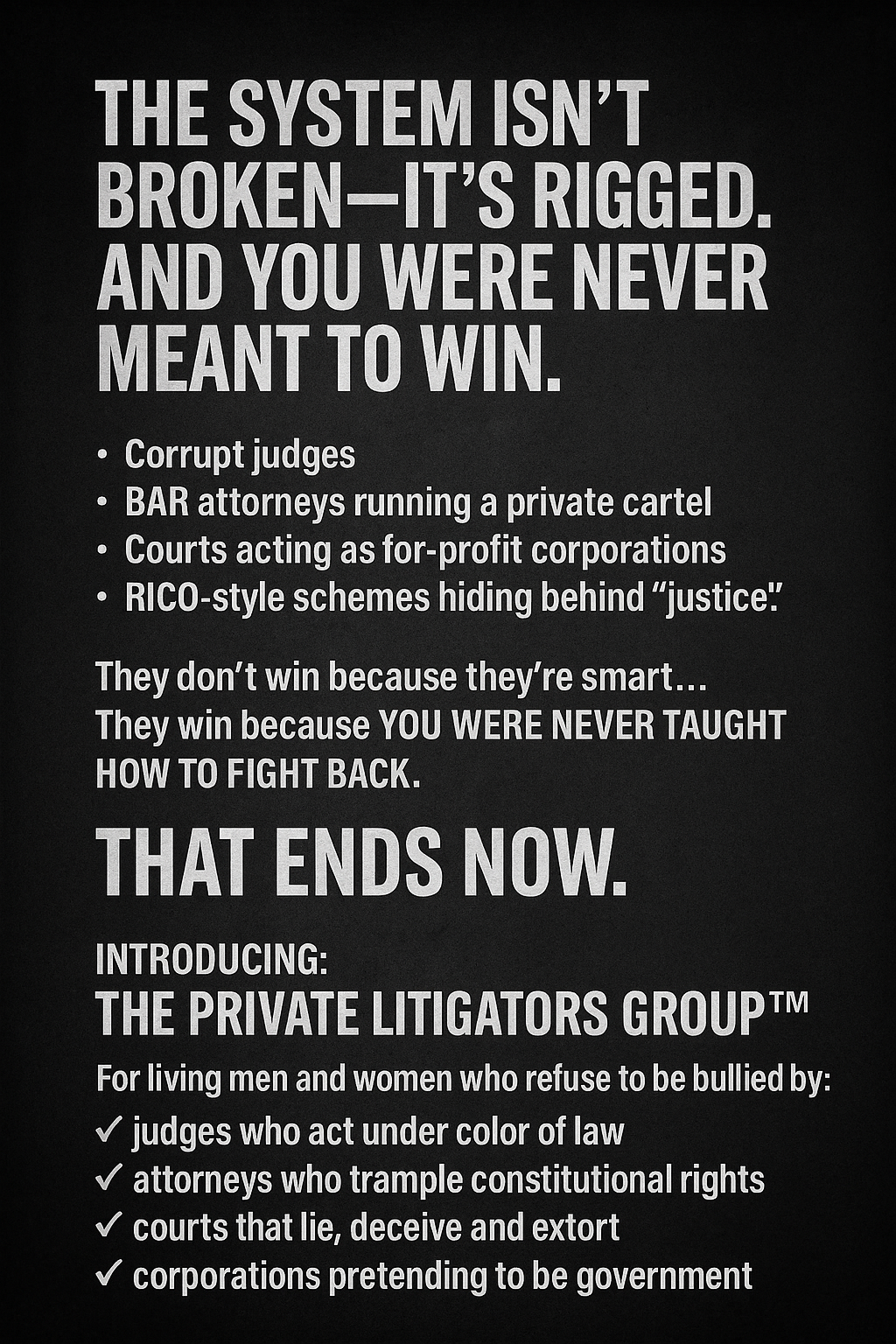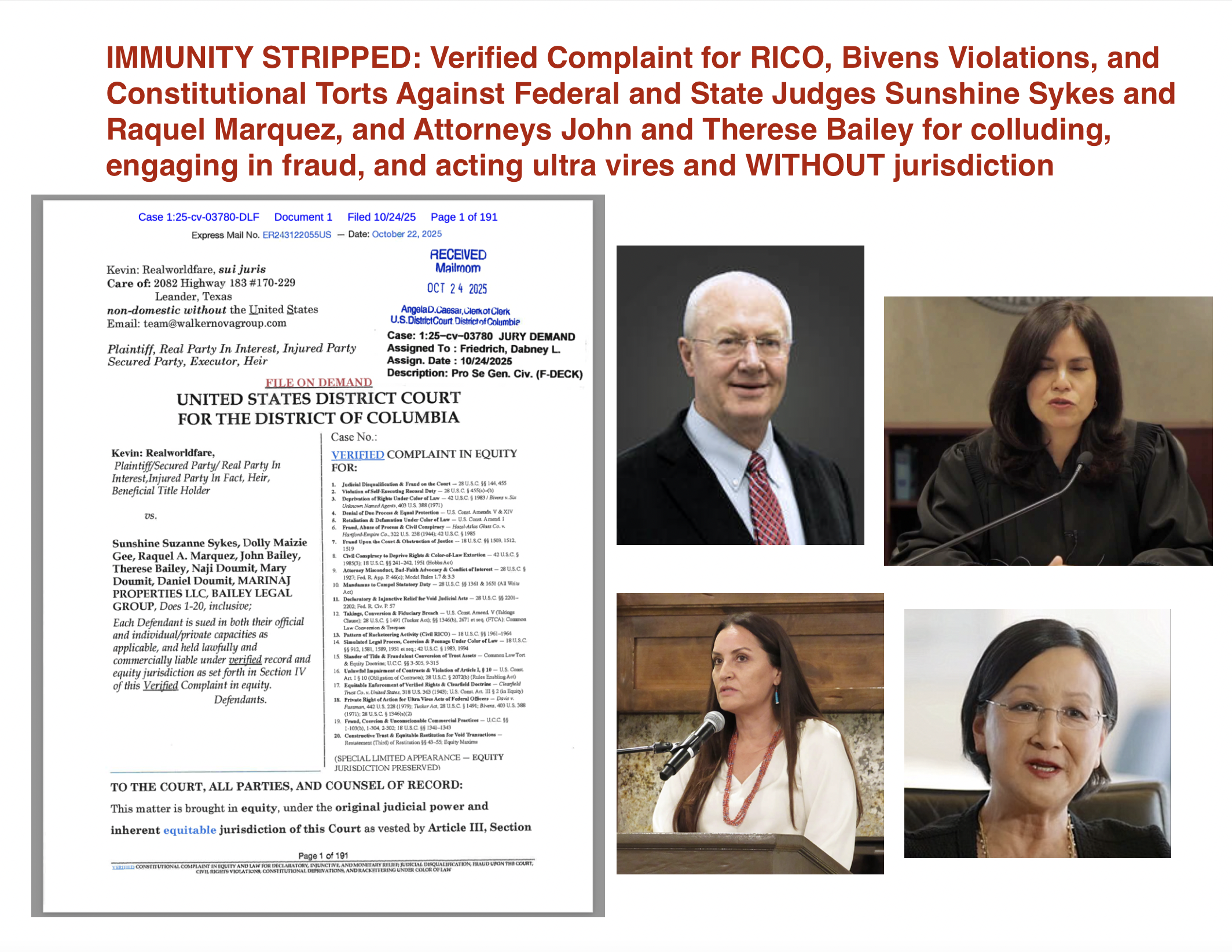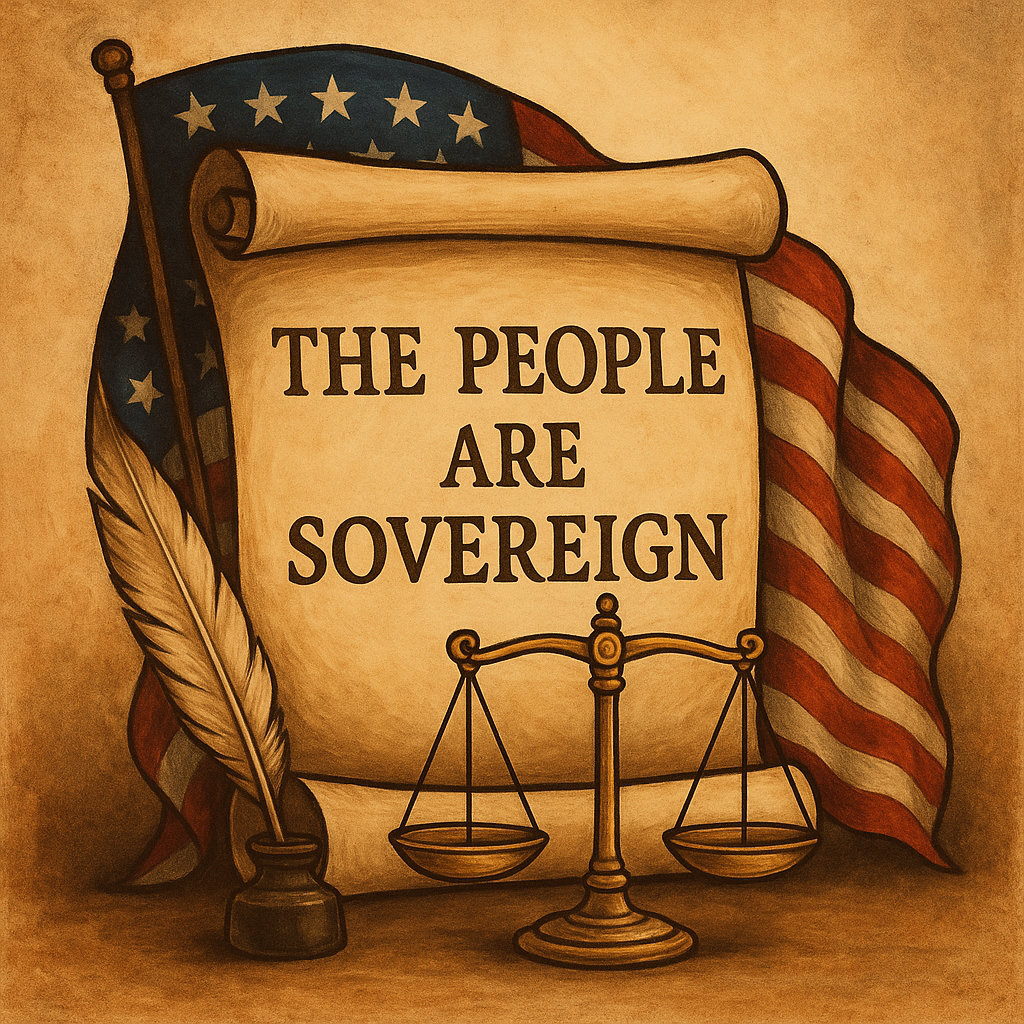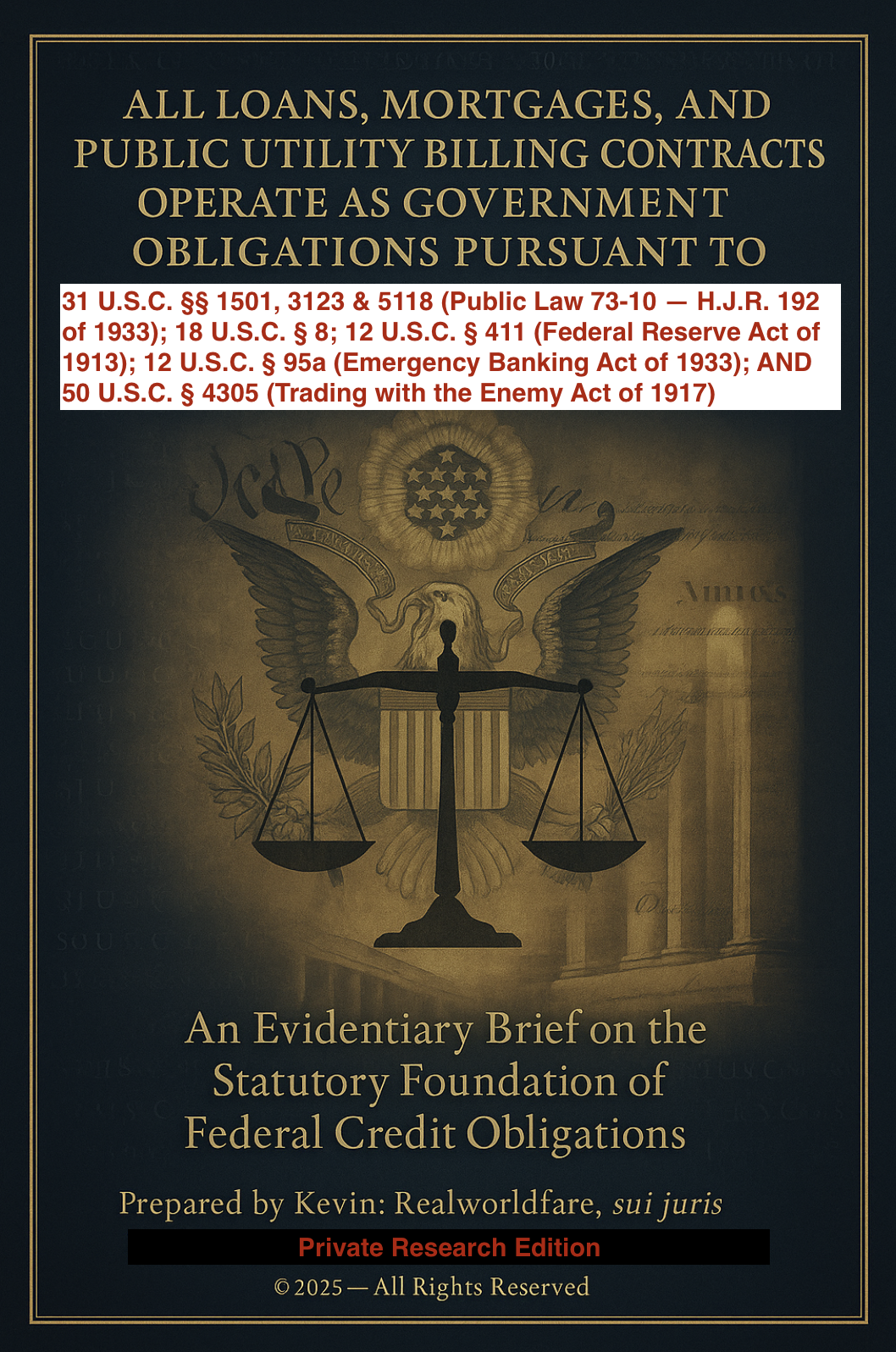Description
NOTICE
NOTICE OF MEMORANDUM OF LAW-Points and Authorities in Support of International Bill of Exchange
“Those who constitute an association nationwide of private, unincorporated persons engaged in the business of banking to issue notes against these obligations of the United States due them; whose private property is at risk to collateralize the government’s debt and currency, by legal definitions, a “national banking association”; such notes, issued against these obligations of the United States to that part of the public debt due its Principals and Sureties are required by law to be accepted as “legal tender” of payment for all debts public and private, and are defined in law as “obligations of the United States”, on the same par and category with Federal reserve notes and other currency and legal tender obligations.”
RE: Item tendered for Discharge of Debt.
The instrument tendered to the bank and negotiated to the United States Treasury for settlement is an “Obligation of THE UNITED STATES,” under Title 18USC Sect.8, representing as the definition provides a “certificate of indebtedness ….drawn upon an authorized officer of the United States,” (in this case the Secretary of the Treasury)”issued under an Act of Congress” (in this case public law 73-10, HJR-192 of 1933 and Title 31 USC 3123, and 31 USC 5103) and by treaty (in this case the UNITED NATIONS CONVENTION ON INTERNATIONAL BILLS OF EXCHANGE AND INTERNATIONAL PROMISSORY NOTES (UNCITRAL) and the Universal Postal Union headquartered in Bern, Switzerland).
TITLE 18 > PART I > CHAPTER 1 > Sec. 1. > Sec. 8.
Sec. 8. – Obligation or other security of the United States defined
The term ”obligation or other security of the United States” includes all bonds, certificates of indebtedness, national bank currency, Federal Reserve notes, Federal Reserve bank notes, coupons, United States notes, Treasury notes, gold certificates, silver certificates, fractional notes, certificates of deposit, bills, checks, or drafts for money, drawn by or upon authorized officers of the United States, stamps and other representatives of value, of whatever denomination, issued under any Act of Congress, and canceled United States stamps.
The International Bill of Exchange is legal tender as a national bank note, or note of a National Banking Association, by legal and/or statutory definition (UCC 4-105, 12CFRSec. 229.2, 210.2, 12 USC 1813), issued under Authority of the United States Code 31 USC 392, 5103, which officially defines this as a statutory legal tender
obligation of THE UNTIED STATES, and is issued in accordance with 31 USC 3123 and HJR-192 (1933) which establish and provide for its issuance as “Public Policy” in remedy for discharge of equity interest recovery on that portion of the public debt to its Principals, and Sureties bearing the Obligation of THE UNITED STATES.
This is a statutory remedy for equity interest recovery due the principles and sureties of the United States for discharge of lawful debts in commerce in conjunction with US obligations to that portion of the public debt it is intended to reduce.
During the financial crisis of the depression, in 1933 substance of gold, silver and real money was removed as a foundation for our financial system.
In it s place the substance of the American citizenry: their real property, wealth, assets and productivity that belongs to them was, in effect, ‘pledged’ by the government and placed at risk as the collateral for US debt, credit and currency for commerce to function.
This is well documented in the actions of Congress and the President at that time and in the Congressional debates that preceded the adoption of the reorganizational measures:
Senate Document No. 43, 73rd Congress, 1st Session, stated,
“Under the new law the money is issued to the banks in return for Government obligations, bills of exchange, drafts, notes, trade acceptances, and banker’s acceptances. The money will be worth 100 cents on the dollar, because it is backed by the credit of the nation. It will represent a mortgage on all the homes and other property of all the people in the Nation.” (Which lawfully belongs to these private citizens.)
The National Debt is defined as “mortgages on the wealth and income of the people of a country.” (Encyclopedia Britannica, 1959.)
Their wealth, …. their income.
The reorganization is evidenced by:
The Emergency Banking Act, March 9, 1933,
House Joint Resolution 192, June 5, 1933 (public law 73-10)
And the Series of Executive Orders that surrounded them:
6073- Reopening of Banks. Embargo on Gold Payments and Exports, and Limitations on Foreign Exchange Transactions. March 10, 1933
6111-Transactions in foreign exchange are permitted under Governmental Supervision. April 20, 1933
6102 – Forbidding the hoarding of gold coin, gold bullion and gold certificates. April 5,
On December 23, 1913, Congress had passed “An Act to provide for the establishment of Federal reserve banks, to furnish an elastic currency, to afford a means of rediscounting commercial paper, to establish a more effective supervision of banking in the United
States, and for other purposes”. The Act is commonly known as the “Federal Reserve Act”.
One fo the purposes for enacting the Federal Reserve Act was:
(3) to authorize “hypothecation” of obligations including “United States bonds or other securities which Federal reserve Banks are authorized to hold” under Section 14(a); 12 USC; ch. 6, 38 Stat. 251 Sect 14(a)
The term “hypothecation” as stated in Section 14(a) of the Act is defined:
“1. Banking. Offer of stocks, bonds, or other assets owned by a party other than the borrower as collateral for a loan, without transferring title. If the borrower turns the property over to the lender who holds it for safekeeping, the action is referred to as a pledge. If the borrower retains possession, but gives the lender the right to sell the property in event of default, it is a true hypothecation.
2. Securities. The pledging of negotiable securities to collateralize a broker’s margin loan. The broker pledges the same securities to a bank as collateral for a broker’s loan, the process is referred to as rehypothecation.”
[Dictionary Of Banking Terms, Fitch, pg. 228 (1997)] As seen from the definitions, in hypothecation there is equitable risk to the actual owner.
Section 16 of the current Federal Reserve Act, which is codified at 12 USC 411, declares that “Federal Reserve Notes” are “obligations of the United States”.
So we see the “full faith and credit” of the United States: which is the substance of the American citizenry: their real property, wealth, assets and productivity that belongs to them, is thereby hypothecated and rehypothecated by the United States to its obligations as well as to the Federal Reserve for the issuance and backing of Federal Reserve Notes as legal tender “for all taxes, customs, and other public dues”.
TITLE 12 > CHAPTER 3 > SUBCHAPTER XII > Sec. 411.
Sec. 411. – Issuance to reserve banks; nature of obligation; redemption
Federal Reserve notes, to be issued at the discretion of the Board of Governors of the Federal Reserve System for the purpose of making advances to Federal reserve banks through the Federal reserve agents as hereinafter set forth and for no other purpose, are authorized. The said notes shall be obligations of the United States and shall be receivable by all national and member banks and Federal reserve banks and for all taxes, customs, and other public dues.
The commerce and credit of the nation continues on today under financial reorganization (Bankruptcy) as it has since 1933, still backed by the assets and wealth of the American citizenry: at risk for the government’s obligations and currency.
Under the 14th amendment and numerous Supreme Court precedents, as well as in equity, Private property can not be taken or pledged for public use without just compensation, or due process of law . The United States can not pledge or risk the property and wealth of its private citizens, for any government purpose without legally providing them remedy to recover what is due them on their risk.
This principle is so well established in English common law and in the history of American jurisprudence. The 14th amendment provides: “no person shall be deprived of…property without due process of law”.
And Courts have long ruled to have one’s property legally held as collateral or surety for a debt even when he still owns it and still has it is to deprive him of it since it is at risk and could be lost for the debt at any time.
The United States Supreme Court said, in United States v. Russell [13 Wall, 623, 627] “Private property, the Constitution provides, shall not be taken for public use without just compensation.”
“The right of subrogation is not founded on contract. It is a creature of equity; is enforced solely for the purpose of accomplishing the ends of substantial justice; and is independent of any contractual relations between the parties.” Memphis & L. R. R. Co. v. Dow, 120 U.S. 287, 301-302 (1887).
The rights of a surety to recovery on his risk or loss when standing for the debts of another was reaffirmed again as late as 1962 in Pearlman v. Reliance Ins.Co., 371 U.S. 132 when the Court said:
…”sureties compelled to pay debts for their principal have been deemed entitled to reimbursement, even without a contractual promise …And probably there are few doctrines better established……”
Black’s Law Dictionary , 5th edition, defines “surety”:
“One who undertakes to pay or to do any other act in event that his principal fails therein. Everyone who incurs a liability in person or estate for the benefit of another, without sharing in the consideration, stands in the position of a “surety.”
Constitutionally and in the laws of equity, the United States could not borrow or pledge the property and wealth of its private citizens, put at risk as collateral for its currency and credit without legally providing them equitable remedy for recovery of what is due them.
The United States government, of course, did not violate the law or the Constitution in this way, in order to collateralize its financial reorganization, but did, in fact, provide
such a legal remedy so that it has been able to continue on since 1933 to hypothecate the private wealth and assets of those classes of persons by whom it is owned, at risk backing the government’s obligations and currency, by their implied consent, through the government having provided such remedy, as defined and codified above, for recovery of what is due them on their assets and wealth at risk.
The provisions for this are found in the same act of “Public Policy” HJR-192, public law 73-10 that suspended the gold standard for our currency, abrogated the right to demand payment in gold, and made Federal Reserve notes for the first time legal tender, “backed by the substance or “credit of the nation”.
All US currency since that time is only credit against the real property, wealth and assets belonging to the private soverign American people, taken and/or ‘pledged’ by THE UNITED STATES to its secondary creditors as security for its obligations. Consequently, those backing the nation’s credit and currency could not recover what was due them by anything drawn on Federal Reserve notes without expanding their risk and obligation to themselves. Any recovery payments backed by this currency would only increase the public debt its citizens were collateral for, which an equitable remedy was intended to reduce, and in equity would not satisfy anything.
And there was no longer actual money of substance to pay anybody.
There are other serious limitations on our present system. Since the institution of these events, for practical purposes of commercial exchange, there has been no actual money in circulation by which debt owed from one party to another can actually be repaid.
Federal Reserve Notes, although made legal tender for all debts public and private in the reorganization, can only discharge a debt. Debt must be “paid” with value or substance (i.e. gold, silver, barter, labor, or a commodity). For this reason HJR-192
(1933), which established the “public policy” of our current monetary system, repeatedly uses the technical term of “discharge” in conjunction with “payment” in laying out public policy for the new system. A debt currency system cannot pay debt.
So from that time to the present, commerce in the corporate UNITED STATES and among sub-corporate subject entities has had only debt note instruments by which debt can be discharged and transferred in different forms. The unpaid debt, created and/or expanded by the plan now carries a public liability for collection in that when debt is discharged with debt instruments, (i.e. Federal Reserve Notes included), by our commerce, debt is inadvertently being expanded instead of being cancelled, thus increasing the public debt. A situation potentially fatal to any economy.
Congress and government officials who orchestrated the public laws and regulations that made the financial reorganization anticipated the long term effect of a debt based financial system which many in government feared, and which we face today in servicing the interest on trillions upon trillions of dollars in US Corporate public debt and in this same act made provision not only for the recovery remedy to satisfy equity to its Sureties, but to simultaneously resolve this problem as well.
Since it is, in fact, the real property, wealth and assets of that class of persons that is the substance backing all the other obligations, currency and credit of THE UNITED STATES and such currencies could not be used to reduce its obligations for equity interest recovery to its Principals and Sureties, HJR-192 further made the “notes of national banks “and “national banking associations” on a par with its other currency and legal tender obligations.
Now TITLE 31 , SUBTITLE IV , CHAPTER 51 , SUBCHAPTER I , Sec. 5103. says,
Legal tender -United States coins and currency (including Federal reserve notes and circulating notes of Federal reserve banks and national banks) are legal tender for all debts, public charges, taxes, and dues. (emphasis added)
But this official definition for ‘legal tender’ was first established in HJR-192 (1933) in the same act that made federal reserve notes and notes of national banking associations legal tender.
Public Policy HJR-192
JOINT RESOLUTION TO SUSPEND THE GOLD
STANDARD AND ABROGATE THE GOLD CLAUSE,
JUNE 5, 1933
H.J. Res. 192, 73rd Cong., 1st Session
Joint resolution to assure uniform value to the coins and currencies of the United States.
As used in this resolution, the term “obligation” means an obligation (including every obligation of and to the United States, excepting currency) payable in money of the United States; and the term “coin or currency” means coin or currency of the United States, including Federal Reserve notes and circulating notes of Federal Reserve banks and national banking associations.
“All coins and currencies of the United States (including Federal Reserve notes and circulating notes of Federal Reserve banks and national banking associations) heretofore or hereafter coined or issued, shall be legal tender for all debts, for public and private, public charges, taxes, duties, and dues,”
[USC Title 12.221 Definitions – “The terms “national bank” and “national banking association”….shall be held to be synonymous and interchangeable.”]
“notes of national banks” or “national banking associations” have continuously been maintained in the official definition of legal tender since June 5, 1933 to the present day, when the term had never been used to define “currency ”or “legal tender” before that.
Prior to 1933 the forms of currency in use that were legal tender were many and varied:
-United States Gold Certificates – United States Notes – Treasury Notes – Interest bearing notes –Gold Coins of United States – Standard silver dollars – Subsidiary silver coins – minor coins – Commemorative coins –
but the list did not include federal reserve notes or notes of national banks or national banking associations despite the fact national bank notes were a common medium of exchange or “currency” and had been, almost since the founding of our banking system and were backed by United States bonds or other securities on deposit for the bank with the US Treasury.
Further, from the time of their inclusion in the definition they have been phased out until presently all provision in the United States Code pertaining to incorporated federally chartered National Banking institutions issuing, redeeming, replacing and circulating notes have all been repealed.
USC TITLE 12 > CHAPTER 2 – NATIONAL BANKS
SUBCHAPTER V – OBTAINING AND ISSUING CIRCULATING NOTES
Sec.101 to 110. Repealed. Pub. L. 103-325, title VI, Sec. 602e5-11, f2-4A, g9, Sept. 23, 1994, 108 Stat. 2292, 2294
SUBCHAPTER VI – REDEMPTION AND REPLACEMENT OF CIRCULATING NOTES
Sec.121. Repealed. Pub. L. 103-325, title VI, Sec. 602f4B, Sept. 23, 1994, 108 Stat. 2292
Sec.121a. Redemption of notes unidentifiable as to bank of issue
Sec.122. Repealed. Pub. L. 97-258, Sec. 5b, Sept. 13, 1982, 96 Stat. 1068 Sec.122a. Redeemed notes of unidentifiable issue; funds charged against
Sec 123 to 126. Repealed. Pub. L. 103-325, title VI, Sec. 602e12, 13, f4C, 6, Sept.
23, 1994, 108 Stat. 2292, 2293
Sec127. Repealed. Pub. L. 89-554, Sec. 8a, Sept. 6, 1966, 80 Stat. 633
As stated in ‘Money and Banking”, 4th edition, by David H. Friedman, publ. by the American Bankers Association, page 78, “Today commercial banks no longer issue currency, ….“
It is clear, federally incorporated banking institutions subject to the restrictions and repealed provisions of Title 12, are not those primarily referred to maintained in the current definition of “legal tender”.
The legal statutory and professional definitions of “bank”, “banking”, and “banker” used in the United States Code and Code of Federal Regulations are not those commonly understood for these terms and have made the statutory definition of “Bank” accordingly:
UCC 4-105 PART 1 “Bank” means a person engaged in the business of banking,” 12CFR Sec. 229.2 Definitions (e) Bank means—“the term bank also includes any person engaged in the business of banking,”
12CFR Sec. 210.2 Definitions. (d)” Bank means any person engaged in the business of banking.”
USC Title 12 Sec. 1813. –Definitions of Bank and Related Terms. – (1) Bank. – The term ”bank” – (A) “means any national bank, State bank, and District bank, and any Federal branch and insured branch;”
Black’s Law Dictionary, 5th Edition, page 133, defines a “Banker” as,
“In general sense, person that engages in business of banking. In narrower meaning, a private person………; who is engaged in the business of banking without being incorporated. Under some statutes, an individual banker, as distinguished from a “private banker”, is a person who, having complied with the statutory requirements, has received authority from the state to engage in the business of banking, while a private banker is a person engaged in banking without having any special privileges or authority from the state. “
“Banking” Is partly and optionally defined as “The business of issuing notes for circulation……, negotiating bills.”
Black’s Law Dictionary, 5th Edition, page 133, defines “Banking”:
“The business of banking, as defined by law and custom, consists in the issue of
notes ……intended to circulate as money…….. And defines a “Banker’s Note” as:
“A commercial instrument resembling a bank note in every particular except that it is given by a private banker or unincorporated banking institution.”
Federal Statute does not specifically define “national bank” and “national banking association” in those sections where these uses are legislated on to exclude a private banker or unincorporated banking institution.
It does define these terms to the exclusion of such persons in the chapters and sections where the issue and circulation of notes by national banks has been repealed or forbidden.
“In the absence of a statutory definition, courts give terms their ordinary meaning. “Bass, Terri L. v. Stolper, Koritzinsky, 111 F.3d 1325,7thCir. Apps. (1996).
As the U.S. Supreme Court noted, “We have stated time and again that courts must presume that a legislature says in a statute what it means and means in a statute what it says there.” See, e.g., United States v. Ron Pair Enterprises, Inc., 489 U.S. 235, 241 -242 (1989); United States v. Goldenberg,168 U.S. 95, 102 -103 (1897);
“The legislative purpose is expressed by the ordinary meaning of the words used. “Richards v. United States, 369 U.S.1 (1962).
Therefore, as noted above, the legal definitions relating to ‘legal tender’ have been written by Congress and maintained as such to be both exclusive, where necessary, and inclusive, where appropriate, to provide in its statutory definitions of legal tender for the inclusion of all those, who by definition of private, unincorporated persons engaged in the business of banking to issue notes against the obligation of the United States for recovery on their risk, whose private assets and property are being used to collateralize the obligations of the United States since 1933, as collectively and nationally constituting a legal class of persons being a “national bank” or “national banking association” with the right to issue such notes against The Obligation of THE
UNITED STATES for equity interest recovery due and accrued to these Principals and Sureties of the United States backing the obligations of US currency and credit; as a means for the legal tender discharge of lawful debts in commerce as remedy due them in conjunction with US obligations to the discharge of that portion of the public debt, which is provided for in the present financial reorganization still in effect and ongoing since 1933. [12 USC 411, 18 USC 8, 12
USC; ch. 6, 38 Stat. 251 Sect 14(a), 31 USC 5118, 3123. with rights protected under the 14th Amendment of the United States Constitution, by the U.S. Supreme Court in United States v. Russell (13 Wall, 623, 627), Pearlman v. Reliance Ins. Co., 371 U.S. 132,136,137 (1962), The United States v. Hooe, 3 Cranch (U.S.)73(1805), and in conformity with the U.S. Supreme Court 79 U.S. 287 (1870), 172 U.S.48 ( 1898), and as confirmed at 307 U.S. 247(1939).]
HJR-192 further declared …….”every provision….which purports to give the oblige a right to require payment in gold or a particular kind of coin or currency….is declared to be against Public Policy; and no such provision shall be….made with respect to any obligation hereafter incurred.”
Making way for discharge and recovery on US Corporate public debt due the Principals and Sureties of THE UNITED STATES providing as “public policy” for the discharge of “every obligation”, “including every obligation OF and TO THE UNITED STATES”, “dollar for dollar”, allowing those backing the US financial reorganization to recover on it by discharging an obligation they owed TO THE UNITED STATES or its sub-corporate entities, against that same amount of obligation OF THE UNITED STATES owed to them; thus providing the remedy for the discharge and orderly recovery of equity interest on US Corporate public debt due the Sureties, Principals, and Holders of THE UNITED STATES, discharging that portion of the public debt without expansion of credit, debt or obligation on THE UNITED STATES or these its prime-creditors it was intended to satisfy equitable remedy to, but gaining for each bearer of such note, discharge of obligation equivalent in value ‘dollar for dollar’ to any and all “lawful money of the United States”.
Those who constitute an association nationwide of private, unincorporated persons engaged in the business of banking to issue notes against these obligations of the United States due them; whose private property is at risk to collateralize the government’s debt and currency, by legal definitions, a “national banking association”; such notes, issued against these obligations of the United States to that part of the public debt due its
Principals and Sureties are required by law to be accepted as “legal tender” of payment for all debts public and private, and, as we have seen, are defined in law as “obligations of the United States”, on the same par and category with Federal reserve notes and other currency and legal tender obligations.
This is what is asserted in the tender presented to the bank for deposit and the government has said nothing to the contrary.
Would we question that this is exactly what Congress has provided for in these statutes and codes on the public debt and obligations of the United States and that this is the remedy codified in statutory law and definition we have cited here? Even though it is never discussed.
Under this remedy for discharge of the public debt and recovery to its Principals and Sureties, TWO debts that would have been discharged in Federal Reserve debt note instruments or checks drawn on the same, equally expanding the public debt by those transactions, are discharged against a SINGLE public debt of the Corporate UNITED STATES and its sub-corporate entities to its prime-creditor without the expansion and use of Federal Reserve debt note instruments as currency and credit, and so, without the expansion of debt and debt instruments in the monetary system and the expansion of the public debt as burden upon the entire financial system and its Principals, and Sureties the recovery remedy was intended to relieve.
Apparently their use is for the discharge and non-cash accrual reduction of US Corporate public debt to the Principals, Prime Creditors and Holders of it as provided in law and the instruments will ultimately be settled by adjustment and set-off in discharge of a bearer’s obligation TO THE UNITED STATES against the obligation OF THE UNITED STATES for the amount of the instrument to the original creditor it was tendered to or whomever or whatever institution may be the final bearer and holder in due course of it, again, thus discharging that portion of the public debt without expansion of credit, debt or note on the prime-creditors of THE UNITED STATES it was intended to satisfy equitable remedy to, but gaining for each endorsed bearer of it discharge of obligation equivalent in value ‘dollar for dollar’ of currency, measurable in “lawful money of the United States”.
Although this has been public policy as a remedy for the discharge of debt in conjunction with removal of gold, silver and real money as legal tender currency by the same act of public policy in 1933, it has been a difficult concept to communicate for others to accept and to know what to do with it, so its never gained common use and for obvious reasons the government has discouraged public understanding of the remedy and recovery under it and therefore it is little known and not generally accessed by the public. But it is still an obligation the United States has bound itself to and has provided for in statutory law and the United States still accepts these non-cash accrual exchanges today as a matter of law and equity. So is the experience of many who have attempted to access the remedy.
That the “public policies” of House Joint Resolution 192 of 1933 are still in effect is evidenced by the other provisions of “public policy” it established that we can see along with these discussed. No one would attempt to demand payment in gold or a particular kind of coin or currency in use or think to write such an obligation into a contract, because the gold standard for currency is still suspended and the right to a ‘gold clause’ to require payment in gold is still abrogated. Both are also part of “public policy” established in HJR-192.
The practical evidence and fact of the United States’ financial reorganization (bankruptcy) is still ongoing today, visible all around us to see and understand. When Treasury notes come due, they’re not paid. They are refinanced by new T-Bills and notes to back the currency and cover the debts. ..something that cannot be done with debt ……unless,…. the debtor is protected from creditors in a bankruptcy reorganization that is regularly being restructured to keep it going.
Every time the Federal debt ceiling is raised by Congress they are restructuring the bankruptcy reorganization of the government’s debt so commerce can continue on.
For obvious reasons the United States government does not like having to recognize all this. It is a very sensitive and delicate matter. And few can speak or will speak authoritatively about it, as the bank has found out.
The recovery remedy is maintained in law because it has to be to satisfy equity to its prime creditors. At this late time, the United States is neither expecting nor intending it to be generally accessed by the public. Regarding such instruments tendered to the Secretary, when public officials are put in a position to legally acknowledge or deny the authority or validity of the instruments, those in responsibility will not deny or dishonor it, or an instrument of discharge properly submitted for that purpose.
The issue is what has the government said about it now?
What is its policy in practice?
And how does it finally respond to such claims of which it receives thousands every day?
It is a fact: Title 31 USC 3123 makes a statutory pledge of the United States government to payment of obligations and interest on the public debt.
TITLE 31 , SUBTITLE III , CHAPTER 31 , SUBCHAPTER II , Sec. 3123. – Payment of obligations and interest on the public debt
(a) The faith of the United States Government is pledged to pay, in legal tender, principal and interest on the obligations of the Government issued under this chapter.
(b) “The Secretary of the Treasury shall pay interest due or accrued on the public debt.”
It is a fact: Title 31 Section 3130 further delineates in its definitions a portion of the total public debt which is held by the public as the “Net public debt”
TITLE 31 > SUBTITLE III > CHAPTER 31 > SUBCHAPTER II > Sec. 3130. Sec. 3130. – Annual public debt report
(e) Definitions. –
(2) Total public debt. – The term ”total public debt” means the total amount of the obligations subject to the public debt limit established in section 3101 of this title.
(3) Net public debt. – The term ”net public debt” means the portion of the total public debt which is held by the public.
It is a fact: Section 3101 references guaranteed obligations held by the Secretary of the Treasury which are excepted and exempted from “the face amount of obligations whose principal and interest are guaranteed by the United States Government”
Sec. 3101. – Public debt limit
(b) The face amount of obligations issued under this chapter and the face amount of obligations whose principal and interest are guaranteed by the United States Government (except guaranteed obligations held by the Secretary of the Treasury) may not be more than $5,950,000,000,000, outstanding at one time, subject to changes periodically made in that amount as provided by law
It is a fact: Every day the United States Treasury department receives dozens or hundreds of such instruments making claims of this type. Obviously some are valid and some are not.
It is a fact: There are only 3 official government directives or alerts that address spurious, fraudulent, fictitious, or otherwise invalid, instruments sent to the US Treasury for payment, and only one that officially states what is to be official US government policy and treatment of them if they are received, this is ALERT 99-10: which is also published on the government website for the United States Treasury: www.publicdebt.treas.gov under Frauds and Phonies,
The Office of the Comptroller of the Currency, Enforcement & Compliance Division in ALERT 99-10 states:
Type: Suspicious Transactions
TO: Chief Executive Officers of all National Banks; all StateBanking Authorities; Chairman, Board of Governors of the Federal Reserve System; Chairman, Federal Deposit Insurance Corporation; Conference of State Bank Supervisors; Deputy Comptrollers (Districts); Assistant Deputy Comptrollers; District Counsel and Examining Personnel.
RE: Fictitious Sight Drafts payable through the U.S. Treasury
It has been brought to our attention that certain individuals have been making and executing worthless paper documents which are titled “Sight Draft” .These items state that they are payable through the U. S. Treasury, 1500 Pennsylvania Avenue, NW, Washington, DC 20220. These instruments are being presented for payment at banks and other businesses throughout the United States. Any of these instruments that are presented to the U. S. Treasury for payment will be returned to the sender and copies will be provided to the appropriate law enforcement agencies.” Dishonored.
This is in conformity with the Uniform Commercial Code that parties may rely on their presentment of obligations as settled unless given a Notice of Dishonor, whether directly applicable to Treasury Dept. officers or not.
UCC3-503. NOTICE OF DISHONOR
…(b) Notice of dishonor may be given by any person: may be given by any commercially reasonable means, including an oral, written, or electronic communication; and is sufficient if it reasonably identified the instrument and indicates that the instrument has been dishonored or has not been paid or accepted. Return of an instrument given to a bank for collection is sufficient notice of dishonor.
…c) Subject to Section 3-504(c), with respect to an instrument taken for collection notice of dishonor must be given…. within 30 days following the day on which the person receives notice of dishonor. With respect to any other instrument, notice of dishonor must be given within 30 days following the day on which dishonor occurs.
These instruments are never returned from the Treasury dishonored.
It is a fact: There is no basis or reason or plausible explanation for such unexplained silence with regard to these particular instruments. Every other branch of the Federal government including the Dept. of the Treasury has developed elaborate libraries of computer generated form letters of statements and replies dealing with almost every possible question or claim that could be made of any agency or department of the Federal government. The United States Treasury has an Office of Public Correspondence whose sole job it is to respond to communications from the general public. THERE IS NO COMMUNICATION SENT TO THE UNITED STATES TREASURY THAT CAN NOT BE RESPONDED TO AS IT MAY REQUIRE.
Many such categories of requests calling for response are far greater in number than claims in equity for recovery to a Prime-creditor over the United States and some categories are far fewer in number, and yet be the requests greater or smaller in number or in complexity of response required, all these of a commercial nature are regularly and timely responded to.
There is virtually no written response by the Federal government to this issue of recovery to the prime-creditors and holders in equity over the United States. The factually observable position of the Secretary of the Treasury and his department in response to THIS type of claim has been ABSOLUTE SILENCE be they from bank, business or private person:
Not denial, disavowal, dishonor, or repudiation of such claims OR their basis in law and fact if they are not true, which in every other case of correspondence to the
Federal government or the Department of Treasury dealing with any question, request or claim: ANY SUCH FALSE CLAIM, MISCONCEPTION OR
MISTAKEN UNDERSTANDING ON THE PART OF THE GENERAL PUBLIC IS TIMELY DEALT WITH IN EVERY CASE BY SUCH FORM LETTERS.
It is the duty of the United States Treasury to the commerce of the nation and in the interests of the general public whom it serves to quickly and conclusively quash and repudiate any such false understandings or claims of remedy in equity on recovery of the public debt in the commercial realm and it is easily within their power to do so.
This despite the fact the only official US government directive from the Department of the Treasury dealing with policy of the government toward fictitious or otherwise invalid instruments sent to the Treasry for collection states clearly “they will be returned to
the sender.”
There is, therefore, no basis or reason or plausible explanation for such unexplained silence with regard to this particular class of instrument except that a remedy in equity for recovery to the prime-creditors over the United States IS true and factual and CANNOT BE DENIED or DISHONORED in equity, and that such Bills of Acceptance in discharge of mutually offsetting obligations between the United States and its holders in equity as secured parties ARE, in fact, being kept, held, and without return or dishonor, accepted as obligations of the United States in the discharge and recovery of the public debt as they make claim on their face to the Secretary of the Treasury to be.
How they are to be recovered on is up to the parties involved holding such obligations and is provided for in law and regulation and administrative procedure a holder or its banking institution may use.
In Conclusion:
When a Commercial Bank sends the instrument to the Secretary for discharge of its own obligations and a problem arises concerning the instrument, a commercial response of some kind is required. There is a legal liability of the government to a negotiable legal tender obligation upon the United States government sent to them for acceptance by a member Federal Reserve Bank after they received it and became responsible for it.
The Treasury has an obligation as a department of government serving the public interest to the bank which as a member of the Federal Reserve System that has a commercial obligation to an account holder and a 3rd party who tendered the item in payment to tell them that its not any good or its not going to be honored, even if they wanted to keep it for prosecution or investigation. This is in effect what the directive says the government will do if its no good. What does statutory law, regulation, or case law tells us about what that obligation is?
They do not dishonor it in any way by return of the item or the sending of any notice to that effect, or make request for additional information or time for examination of the instrument, or given a statement of explanation indicating the time frame for its review and settlement if it would be an inordinately lengthy time as longer than 60 days to finish with it. The instruments are being kept, held, and without return or dishonor, are accepted as an obligation of the United States in the discharge and recovery of the public debt as it makes claim on its face to be.
Put another way: If the bank had had to pay the item to honor its customer agreement as if it had been a check, what would or could the bank be trying to do with it to finally settle the account? The bank needs to treat the Instrument tendered as an obligation of the United States to the bank. The tender of these Instruments discharge the obligation of the debt for which they are delivered and the payee becomes the new holder in due course and collection agent on the Instruments.
